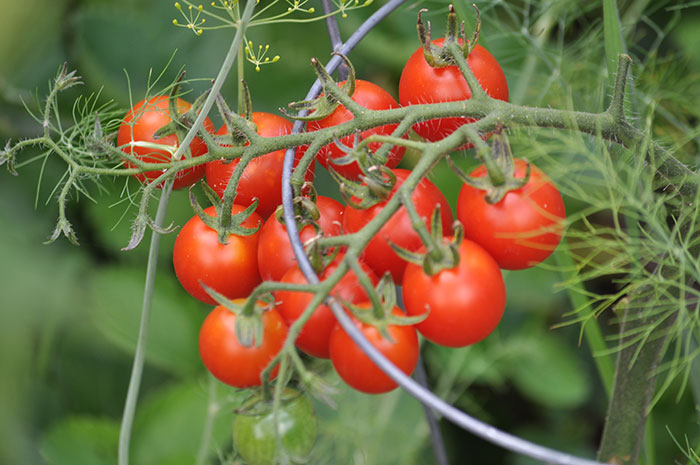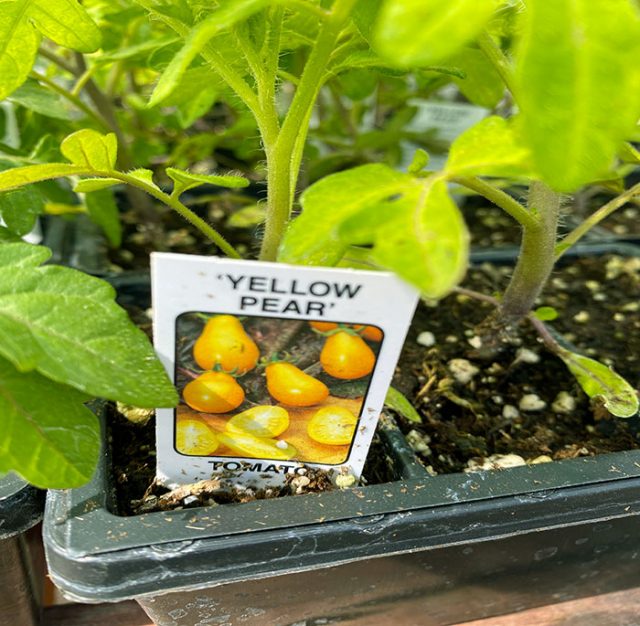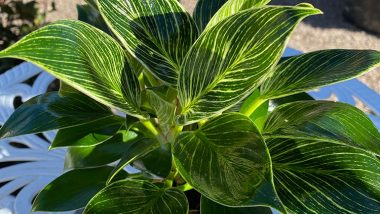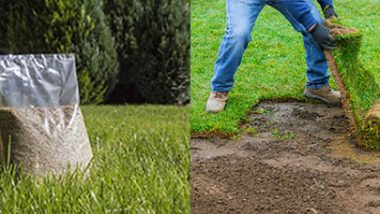Last updated on January 3rd, 2026 at 07:08 am
The Best way to grow cherry tomatoes. There are numerous ways to grow these sweet, delicious tomatoes. You can grow them indoors, outdoors, in pots, and in garden beds.
One main reason I love cherry tomatoes is that they are one of the easiest tomatoes to grow. They grow quickly and depending on the variety are ready to harvest in about 60 – 80 days or so. There are many types of cherry tomatoes, red, purple, and orange.
The oblong ones are called grape tomatoes. I like the red type as they are sweet, and you can eat them right off the plant provided you grow them organically.
You can start them as seeds or purchase them in small containers at your local nursery store. I recommend purchasing them from a local independently owned nursery. The big box stores will also carry them, but they are rarely taken care of the way a local nursery does.
There are lots of varieties but the ones on this post are the most common.
Plant them in pots or garden beds
They can grow in pots, outdoors, indoors, upside down, or mixed in with other vegetables in the garden. They are easy to grow and will produce tomatoes from mid-spring until the first light frost. Most cherry tomatoes are indeterminate, meaning they will be bear tomatoes until late fall.
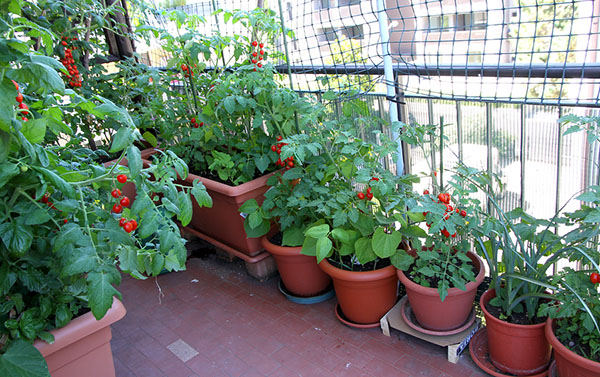
Watering and Fertilizing
Tomatoes like to be well watered every other day during the spring seasons and more often in mid-summer. Use good composted potting soil and fertilize with a good vegetable type of fertilizer. An excellent choice is Happy Frog’s tomato fertilizer.
Soil to use
Growing tomatoes love good well-composted soil. Are you growing tomatoes in pots, and then using the best soil on the market today? Fox Farm’s Happy Frog or Ocean Forest soils. Most independently owned Nurseries in the U.S.A. will have this soil in stock.
If you are going to plant in a garden bed you can use this soil at about 75% Fox Farm soil and 25 % of your native soil.
They will need some type of support, a trellis, or a fence, but the best is to use a good tomato cage. The pH level for these tomatoes should be acidic somewhere in the 6.3 – 6.5 range. Learn more here “Changing pH in soil”.
Where to place Cherry Tomatoes
In full sun, their skin is thicker than most other types of tomatoes. However, around the American Southwest place them where they can get lots of early morning sun and some afternoon shade. Less likely to get sunscald.
It is best to use a good tomato cage as opposed to stakes. Make sure you install them before your tomatoes start to grow. Observe your plants a couple of times per week and place the tomatoes over the metal rim. There are many cages, but the best is the pyramid type they are less expensive.
Tomato cages can also be used with containers be sure you have a container that is wide enough for your cage. Another advantage to using containers is that you can move the containers around. during the Mid-summer heat around the southwest tomatoes can get damaged due to too much sun. However, if they are in a pot you can easily move them to a shadier spot. Morning sun or afternoon shade works best.


Types of Cherry Tomatoes
Sweet 100
The most common of all are the Sweet 100 Cherry Tomatoes. As the name suggests, they are sweet and watery. Profuse growth from mid-spring until late summer. They will mature in about 65 days and will bear clusters of 100 or more sweet cherry tomatoes.

Grape Cherry
Not as sweet as the common Cherry Tomatoes. Thicker skin and much more meat. They are smaller and look a lot like grapes, thus their name. They were introduced to the U.S. in 1997.
According to Wikipedia A grape tomato is a class of tomatoes believed to be of southeast Asian origin, shaped similarly to the oval plum tomatoes but having the small size and sweetness of cherry tomatoes. Grape tomatoes produce small and typically oblong fruits. Read more here.
Large Red Cherry
As the name suggests, these tomatoes are dark red in color and about 2″ in diameter. Can be harvested in about 80 days or so. Will produce tomatoes until late fall, and around the Southwest, this means late October. These are great for salads but not as sweet as other types.
Yellow Pear
This tomato has a pear shape and is sweet to taste. They will bear lots of tomatoes and love the full sun and lots of water. They will mature in about 75 – 80 days and will produce tomatoes all summer long.
Problems with Cherry Tomatoes
Like most vegetables, you will have to deal with insects, diseases, and fungi.
Insects love these tomatoes, especially aphids and spider mites as these little insects will suck on the stems and leaves, which will weaken your plants. Best to use a good organic insecticide to kill these bugs. Neem oil and insecticidal soaps will kill them. How to use insecticidal soaps.
Curly top Leaf on tomatoes. There are two things that cause this problem: one is herbicides being used nearby. The mist from any type of herbicide will cause the foliage of tomatoes to curl.
Curly top Virus will also cause tomato leaf curl. There is no cure for this disease; however, keeping insects away from your tomato plants is the best deterrent to keeping this virus from invading your plants. The Leafhopper is the most common insect.
Blossom end rot. This is caused by not having enough calcium in the soil and is the most frequent problem. Usually, a deep brown or almost black appearance on the bottom of the tomato. The cure is easy: incorporate some calcium into the soil. You can use crushed eggshells, and dolomite lime, as an organic substitute. There are foliar calcium sprays that do the job quickly and easily. I recommend Bonide Rot Stop spray. Ask for it at your local nursery.
The top four things to remember
- Good loamy soil
- Water often daily during the summer heat
- Fertilize with a good organic fertilizer
- Observe your plants often – Act quickly with diseases or insects
- If Possible provide them with some shade during the hot summer months.

Greenhouse Manager, Master Gardener, and Webmaster.
If you have any questions or enjoyed this post, feel free to share your thoughts in the comments below.

